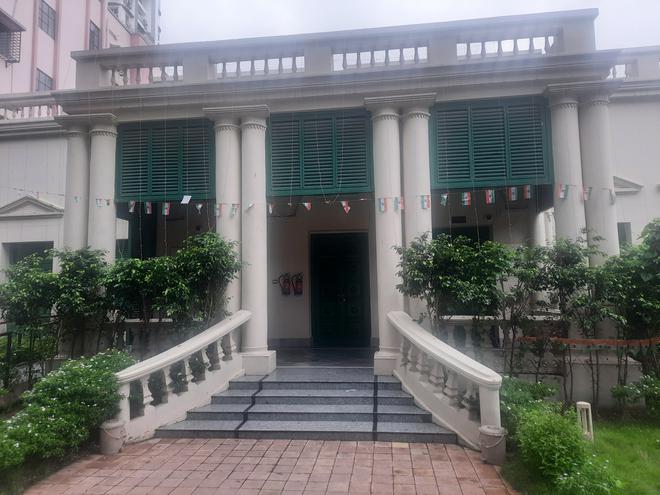The gates of Hyderi Manzil, or Gandhi Bhawan, as it is called these days, remained closed till 10 a.m. on August 15, 2022, when the caretaker of the building arrived and started wiping a marble statue of Mahatma Gandhi in the courtyard. The national flag was unfurled only after spells of rain stopped, well past 11 a.m., with a dozen people who disappeared as quietly as they had arrived.
A pocket watch, a lantern, wooden slippers, charkhas, a metal tumbler, and a walking stick; all personal items used by Mahatma Gandhi remain in the fasting room, which hardly had any visitors today. Termites have surfaced on the very first frame of the yet-to-be inaugurated exhibition on the Father of the Nation. Gandhi Bhawan felt as lonely in the 75th year of Independence as it was on August 15, 1947, when Gandhi stayed in this single-storey house on the day the country got its freedom.
“As it happened, Mahatma Gandhi was not present at the festivities in the capital on August 15, 1947. He was in Calcutta (now Kolkata), but did not attend any function or hoist a flag there either. Gandhiji marked the day with a 24-hour fast,” one of the panels of the exhibition reads. “He was residing at this address, Hyderi Manzil, which was decorated with the Indian Tricolor by Hindu and Muslim volunteers,” it says, highlighting the historical significance of the place.
When Gandhi decided to stay in Kolkata, he purposely chose Hyderi Manzil in Beleghata, which was known as Miabagan, a prominent Muslim neighbourhood. In 1947, Mahatma Gandhi was meant to go to riot-torn Noakhali (now in Bangladesh) but was entreated by many to save Kolkata.

He arrived at Gandhi Bhawan a few days before August 15 and stayed here till September 6. It was at this building that Gandhi went on a fast on September 1 when communal violence erupted again in parts of the city. The fast continued for 73 hours, after which many who were rioting came to Gandhi and surrendered their weapons. A few old, coarse but sharp iron weapons that were laid down before the Mahatma are still on display in the fasting room next to his personal belongings, bearing witness to the troubled times.
Delay in inaugurating exhibition
The exhibition spread over 3000 sq ft inside the historic Gandhi Bhawan with dozens of panels on different events in Gandhiji’s life and his interaction with different personalities is waiting to be inaugurated. The officials of the Information and Cultural Affairs Department of the West Bengal government, who have maintained the building since 2019, said they are waiting for a date from “higher authorities” to inaugurate the exhibition.
Also read: India at 75 | Changing contexts of caste
The gates of the building are usually closed to everyone, and it takes a lot of persuading for authorities to allow people inside as the country celebrates its 75th year of independence.
Stories of Gandhi’s stay in the area
Most people with whom Gandhi had interacted in the locality have died, but some stories about the stay still mill around. Jayanta Nath, a member of the Purba Kolkata Gandhi Smarak Samiti, recalled the story he had heard about how a few local youths had stolen a goat whose milk was served to Mahatma Gandhi, hoping that it would make him leave the place.
“I have not seen Gandhiji but in 1969 on his 100th birth anniversary, Frontier Gandhi Khan Abdul Gaffar Khan had visited this place and said ‘Hindu Muslim Bhai Bhai’,” Mr. Nath recalled.

Locals, particularly caretaker Dilip De, recall the visits by former West Bengal Governor Gopalkrishna Gandhi, who had played a crucial role in restoring the building, located in a densely populated north Kolkata neighbourhood. Mr. Gopalkrishna Gandhi had told this correspondent that Gandhi Bhawan was a “monument to the freedom struggle’s commitment to India’s composite culture” and a “site that ranks next only to the house on Tees Janvari Marg in New Delhi for the power of its historical magnetism”.
The historical significance of the Gandhi Bhawan and the memories of the Father of Nation, particularly during the freedom hour, may not have drawn the people of Kolkata to its gates, but Aniruddha G. Haldipurkar had decided to spend the 75th year of the country's independence at this place.
Also read: India at 75 | The marginalisation of the Indian Muslim
“I had planned this two years ago. I used to ask people where Gandhiji was when the country got Independence, but not many of them knew about this place.”
Mr. Haldipurkar, who said that Gandhiji had stayed in their home at Karwar in Karnataka in 1934, had visited most of the places associated with Mahatma on his 150th birth anniversary in 2019. As the advocate, dressed in a Gandhian cap and a tricolour scarf, stood in front of the mattress where the pocket watch, the charkhas and slippers, and wooden stick have been kept on display, he said, “Tears come to my eyes, thinking of what the great man must have gone through on August 15, 1947.”







